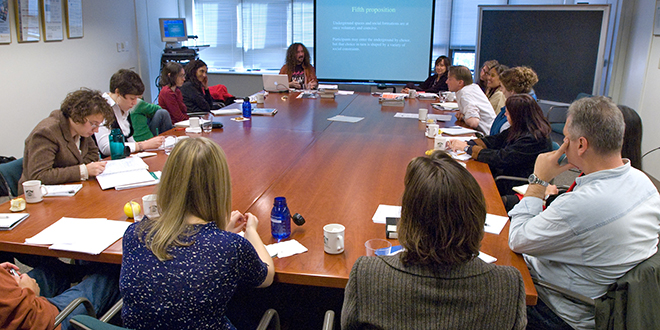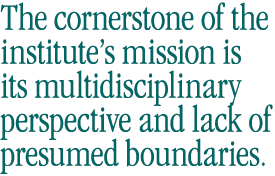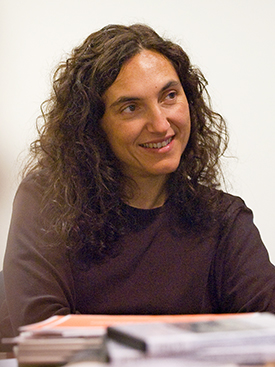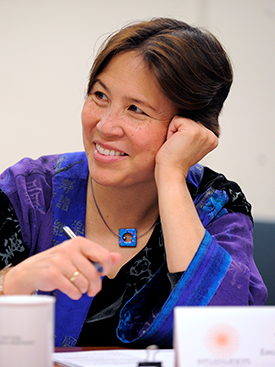

At the interdisciplinary Kahn Liberal Arts Institute, risky exploration is encouraged. Here, Smith students, alongside faculty scientists and literary scholars, philosophers and artists, explore elusive notions and research questions as far ranging as how the idea of “making” infuses our sense of the world or what makes the concept of “perception” an essential form of human experience.

/ Published December 7, 2016

Twice a week throughout the academic year, library users on the third floor of Neilson might hear a steady hum of conversation coming from behind a set of double doors in the south wing. Sometimes the discussion is punctuated by laughter; other times it takes the form of impassioned debate or disagreement.
This is the sound of Kahn Liberal Arts Institute fellows at work—participants in the center’s projects, drawn from across the faculty, staff and student body. This year’s projects deal with questions related to perception (Shaping Perception) and with the porous notion of “making” (Modes and Models of Making); next year, colloquia will grapple with issues associated with the environment (Destroy, Then Restore) and with the complexities associated with human conflict (War).
Since the institute’s inaugural project, Ecologies of Childhood, in 1998, more than 300 faculty and staff members and more than 300 students have taken part in 32 long-term projects. The Louise W. and Edmund J. Kahn Liberal Arts Institute’s mission is to provide opportunities outside the Smith curriculum for scholarly development in a collaborative setting. The cornerstone of that mission is its multidisciplinary perspective and lack of presumed boundaries—between faculty and students, among disciplines, or between the scholarly and the social.

Bosiljka Glumac
The weekly Kahn projects, called colloquia, begin as a germ of an idea between two faculty members in different departments. Working with the institute’s director, the faculty organizers create a description of a complex issue—such as the subjectivity of evil or the barriers to educating women worldwide—that has no easy or single solution and that requires the input of scholars across many disciplines over time. Gathering colleagues and students into a group of about 20, faculty organizers lay out a plan for the coming year in which open-ended discussion, visiting speakers and shared readings help each participant deepen his or her understanding of the topic. Each week, following two hours of difficult intellectual work, the group sits down and shares a meal—to discuss their work and wind down.
Although there are no expectations for publishing or other tangible outcomes from Kahn participation, this kind of open-ended exploration has produced a great deal of scholarly output, including books and articles, plays, films and artwork. I Died for Beauty: Dorothy Wrinch and the Cultures of Science (Oxford University Press, 2012), by Marjorie Senechal, Louise Wolff Kahn Professor Emerita in Mathematics and History of Science and Technology, grew out of work she did in the yearlong Kahn project Wellness and Disease (2009–10). Academy Award–winning filmmaker Sharmeen Obaid-Chinoy ’12 started her earliest documentary film, Terror’s Children, while still a student fellow in a Kahn seminar. And the recent film A Small Life by Lynne Yamamoto, Jessie Wells Post Professor and professor of art, and Lucretia Knapp, lecturer in art, is based on their research in the Kahn yearlong project Memory: Form, Function and Fallibility (2015–16); the film premiered at this year’s Hawaii Film Festival.
With fewer boundaries and no output requirements, Kahn institute programs allow faculty, staff and students to more freely explore ideas, take risks and engage in a kind of creative thinking that otherwise might not be possible.
“The Kahn Institute setting really encourages exploration—risky exploration,” says Bosiljka Glumac, professor of geosciences, who has participated in two yearlong Kahn projects. “I have taken that idea to my research as well and have applied it in my teaching, specifically when I work with students at the entry level.”
Faculty members have also used Kahn projects as springboards for curricular innovation. Out of her work in the Kahn short-term project The Making and Meaning of Dress (2011), Janie Vanpée, professor of French studies, developed a course built on creating an online exhibition of luxury objects from the time of Marie Antoinette.
Adam Hall, professor of biological sciences and a faculty organizer for Memory: Form, Function, and Fallibility, also sees valuable connections between the Kahn and the classroom. “I’m developing a course in the cellular molecular basis of learning and memory, and really thinking much more deeply about this topic and what memory entails,” Hall explains. “The Kahn experience has enabled me to draw from examples in the humanities and to make material more accessible to students. I’ve added little components—say, Proust and the olfaction triggering memories—and then described the neurobiological pathway. If you can throw in some literature and discuss that with the students, they can place the neurobiology in the context of their everyday lives, their reading, their experiences. I think it makes them keener to learn about the neuroscience.”
Among the most unique features of the Kahn Institute is its capacity to engage faculty and students across all three divisions, notes Rosetta Cohen, director of the Kahn Institute and professor of education and child study. “Many colleges and universities have humanities institutes. Very few cast such a wide net across all fields—scientists and literary scholars, psychologists and artists. Bringing all these minds together with no pressure for a concrete outcome has proven to be extraordinarily generative. As a result, Kahn projects become exceptional incubators for innovation and creativity.”
Cohen recalls her experience as a faculty fellow in the Kahn project Narrative: Identity (2009–10), organized by Bill Peterson, a professor of psychology at the time (now serving as associate provost and dean for academic development) and Andrea Hairston, Louise Wolff Kahn Professor of Theatre. “I was writing about teacher burnout—interviewing veteran teachers about their experiences over time,” Cohen says, “and a reading proposed by Bill totally transformed the direction of my work. ‘Look at the psychological literature on hardiness,’ he said. ‘Most of it has been done with soldiers, but you might find good stuff that relates to your work with teachers.’ He was right: his suggestion opened the door to a whole new way of thinking about my subject. That is the kind of thing that happens all the time in the Kahn.”

Naomi Miller
Bosiljka Glumac, a faculty fellow in the projects Underground and Underworlds (2007–08) and Time: Its Meaning and Measurement (2009–10), speaks to the creative risk taking that is encouraged in the Kahn Institute. “Working in a Kahn project allows you to go outside your comfort zone and seek relationships and connections beyond your discipline. For example, as a scientist, I decided that I wanted to explore relationships between art and science. I designed a course called Archaeological Geology of Rock Art and Stone Artifacts (ARC 112). Thinking about relationships between science and art and human experience was inspired and informed through my Kahn involvement. I don’t think I would have been courageous enough to do it if it wasn’t for the support and ideas or the structure that Kahn provides through its interdisciplinary nature.”
Ultimately, the human factor is what instills such enduring impressions on student, faculty and staff participants in Kahn projects, emphasizes Naomi Miller, professor of English language and literature and a veteran of three Kahn long-term projects. “You’re literally breaking bread together during the weekly meals,” she says. “You’re finding out, ‘Oh, what was hard for you this week?’ And you share. Often, you just don’t have enough time to socialize with all of the faculty you’d want to get to know here. So to be able to meet every single week for an entire year with a core group of different faculty and students is invaluable.”
For Miller and other project fellows, the primary benefit of the Kahn experience can be easily summarized.
“For me, the Kahn was really a collaborative experience of learning,” Miller says, “a learning community in the best sense. For a whole year you can actually learn on multiple levels, across intersecting disciplines, as long as you’re willing to engage. That’s what the Kahn is all about.”
Note: During the construction of the new Neilson Library, beginning in summer 2017, the Kahn Institute will relocate to 21 Henshaw Avenue.














